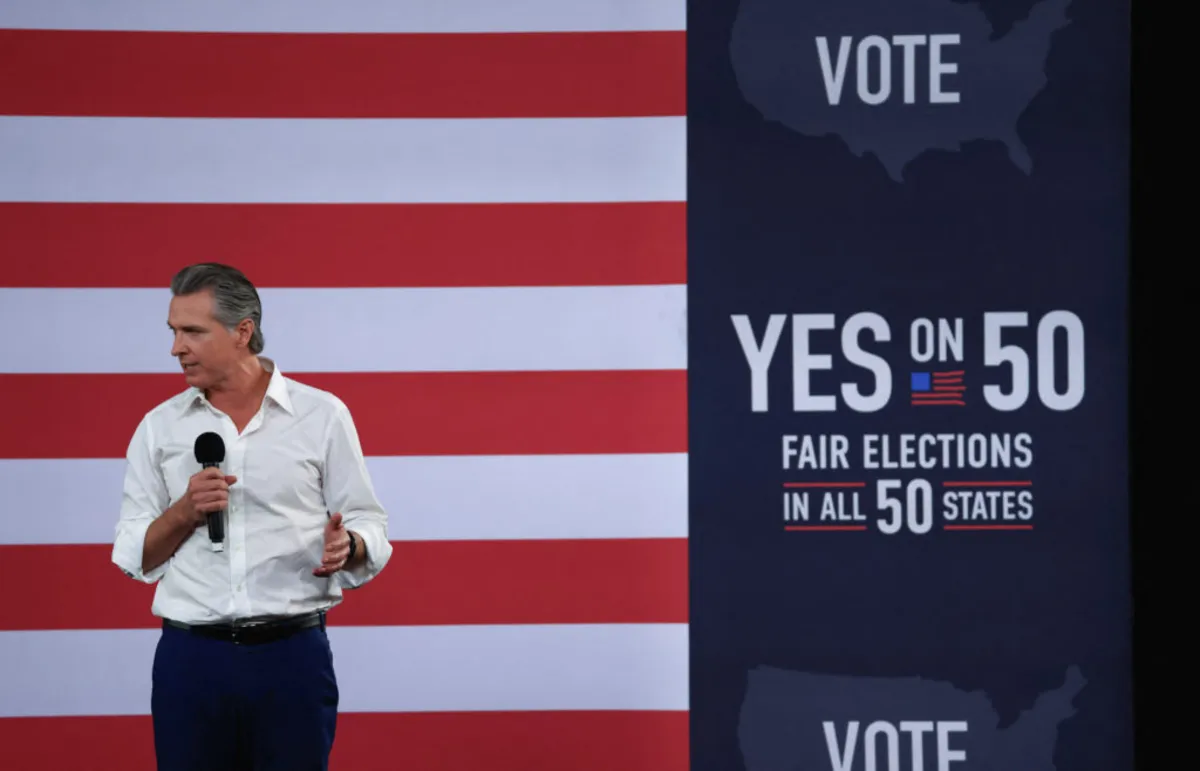
California Democrats, led by Governor Gavin Newsom, are pushing for a transformative congressional map that has the potential to flip up to five U.S. House seats from Republican to Democratic control. This pivotal change hinges on voter approval, as California residents prepare to head to the polls on Tuesday to vote on Proposition 50. This proposition seeks to implement a new congressional map, which was approved by the state legislature in August, for the next three election cycles. Following the 2030 U.S. Census, the state's independent redistricting commission will take over the task of drawing maps again.
Across the nation, politicians are actively reshaping congressional voting districts, a process typically conducted once every decade after the census. This effort aims to provide electoral advantages for their respective parties in the upcoming elections. The national discourse around partisan gerrymandering gained momentum in Texas, where a new map was adopted in August under the Republican-controlled state government, potentially flipping five Democratic-leaning House seats.
California is now following suit. Since the passing of the congressional map by the California legislature, other states like Missouri and North Carolina have also enacted new maps. The outcome of California's Proposition 50 could significantly impact the balance of power in the U.S. House after the 2026 midterm elections, a period when Republicans typically aim to counter the trend of the incumbent president's party losing seats.
As of now, Republicans hold a narrow margin with 219 seats compared to the Democrats' 213, alongside three vacant seats. If Proposition 50 gains approval, it could enable Democrats to control as many as 48 of California's 52 congressional seats, a rise from the current 43 seats they hold. Some of the newly drawn districts will traverse diverse regions, merging rural, conservative areas of northern California with the liberal stronghold of Marin County, situated north of San Francisco. In contrast, some districts will remain largely unchanged or only experience minor modifications.
Both proponents and opponents of Proposition 50 have mobilized significant financial resources, with over $200 million contributed to the campaign. If support for the measure aligns with party lines, the Democratic-backed "Yes" campaign is expected to prevail. The Democratic Party enjoys a substantial statewide voter registration advantage, surpassing Republicans by over 4.5 million voters. In the last presidential election, Democratic candidate Kamala Harris won California by approximately 20 percentage points.
On the other side, opponents of Proposition 50, including prominent Republican figures such as former House Speaker Kevin McCarthy, have raised over $80 million. The Congressional Leadership Fund, a super PAC aimed at electing Republicans to the House, has contributed an additional $5 million. The "No" campaign also features high-profile endorsements, including former Governor Arnold Schwarzenegger, who has been a vocal opponent of gerrymandering. They argue that the initiative is a tactic by Democrats to enhance their influence while undermining the voter-approved independent redistricting commission.
Governor Newsom, along with state and national Democrats, has been actively campaigning for Proposition 50. Newsom personally contributed $2.6 million from his campaign funds, while the House Majority PAC, an independent group supporting Democratic House candidates, invested nearly $15 million. The Associated Press will not make predictions but will report on significant developments as they occur, including candidate concessions or victory declarations.
California's special election is set for Tuesday, with mail-in voting having been available for several weeks. Polls will close at 8 p.m. PT (11 p.m. ET). The ballot will feature the critical vote on the redistricting measure. All registered voters in California are eligible to participate in this special election.
As of September 5, California had approximately 23.1 million registered voters, with 45% identifying as Democrats and 25% as Republicans. About 5.2 million voters are registered as independents. Previous turnout for off-year elections, such as the 2021 gubernatorial recall, was around 58%. By October 28, nearly 4.74 million ballots had already been cast ahead of Election Day. The AP Early Vote Tracker will provide updates on voting data.
Vote counting typically extends into the night, with the AP having reported results from California shortly after polls closed during the previous presidential election. Notably, there are no automatic recounts in California; however, registered voters may request one, although they are responsible for funding it. The AP will declare winners based on the lead size and the potential for recounts or legal challenges.
As voters prepare to cast their ballots, there remain 364 days until the 2026 midterm elections and 1,099 days until the 2028 general election. The implications of this election extend beyond California, shaping the future of congressional representation and party control in the United States.
For more insights and updates on the electoral landscape, continue following our coverage of Vote 2025 and related developments across the nation.